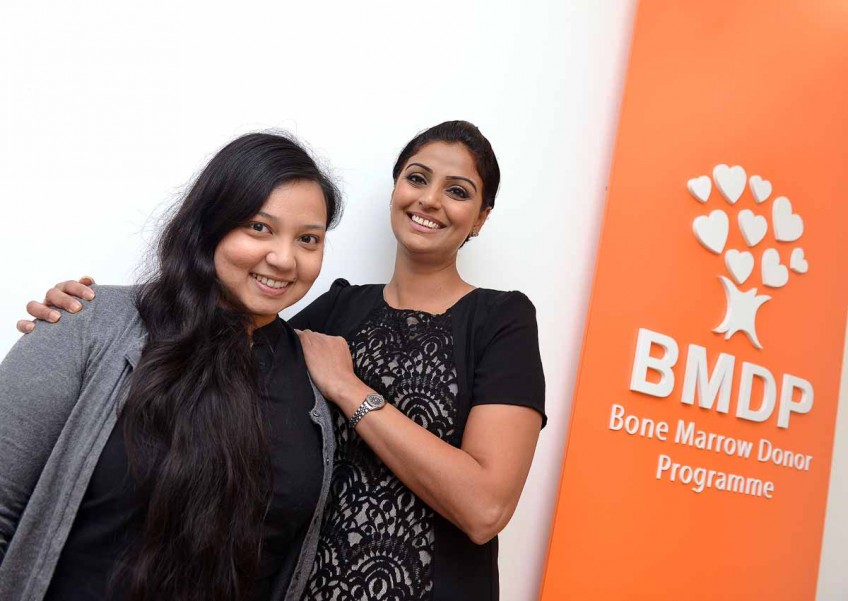Tears as bone marrow recipient meets donor

Ms Deshi was an ambitious flight attendant living the jet-setting life when she started to get bruises on her body that would not fade.
Worried, she went for a check-up in January last year and was found to have acute myeloid leukaemia, a strain of blood cancer.
For the next few months after that, she went through aggressive treatments and suffered infections that kept her weak and hospitalised, unable to eat or drink.
Many times, she felt close to giving up.
"I felt so demoralised and dejected sometimes.
"I went from a flight attendant to someone who couldn't do anything and needed help to use the toilet," said Ms Deshi, 32, who did not want her full name to be disclosed.
She would have died six months after her diagnosis if she did not get a bone marrow transplant, her doctor said.
Now, 18 months after her diagnosis, Ms Deshi is alive and healthy and even certified fit-to-fly recently.
This is all thanks to Ms Sheila A. Nair, whose bone marrow donation a year ago saved her.
Yesterday, the two women met for the first time.
Ms Nair, 27, an accounts executive, had a nervous smile as she waited to meet the person whose life she had changed.
When Ms Deshi walked through the door, they embraced each other tightly.
Tears streaming down her face, Ms Deshi thanked Ms Nair repeatedly.
"Sheila is a part of me, her cells are in my body. She's like my sister," she said.
Ms Deshi's mother, Madam Rani Kaur, 55, sobbed as she thanked Ms Nair - her "new daughter".
The meeting was organised by the Bone Marrow Donor Programme (BMDP), which is dedicated to expanding and managing Singapore's only register of volunteer bone marrow donors.
Ms Nair became a donor when she chanced upon their booth in Potong Pasir Community Centre as a 17-year-old.
When she got the call about a match, she was surprised. The chances of a perfect bone marrow match with unrelated persons are around one in 20,000.
BMDP currently has about 65,000 donors in its local register.
Last year, the non-profit group helped facilitate 58 transplants here, of which 15 involved local donors.
There has been an increase in new donors each year and they hope the registry will surpass 100,000 donors by 2018.
"When we can match local donors instead of foreign donors with local patients, we save a lot of time. And one thing patients really don't have is time," said BMDP chief executive Jane Prior.
Getting donors can be hard as misconceptions surround bone marrow transplant procedures.
For Ms Nair, however, joining the programme was a no-brainer.
"Well, if you can do something good, then why not?"
Bone marrow transplant FAQ
Q: What is a bone marrow/stem cell transplant?
A: It is the replacement of diseased marrow with marrow from a healthy donor.
Q Who can become a bone marrow donor?
A: Anyone between the ages of 17 and 49 of good health can be a donor. The Islamic Religious Council has also given approval for all Muslims to be donors.
Q How is bone marrow collected from a donor?
A: There are two methods.
- There is the bone marrow harvest method in which bone marrow, which contains stem cells, is removed from the back of the pelvic bone using a special needle. The process takes 45 to 60 minutes under general anaesthesia.
- The peripheral blood stem cell harvest method gives donors four daily injections of a naturally occurring hormone to stimulate the growth of stem cells. On the fourth day, the cells will be collected in an outpatient procedure very similar to a blood donation except that it will take five to seven hours. The method of harvest is selected based on the recipient's condition.
Q: Is the bone marrow transplant procedure painful?
A: Donors might experience slight discomfort but all discomfort should be gone in a week. Most can return to their daily routines almost immediately.
Q: Are there any long-term side effects linked to the procedure?
A: There are no known long-term side effects. Donors should see their blood count return to normal within four weeks.
Q: If I come up as a match, do I have to pay for the procedure?
A: No. Donors will be reimbursed for all expenses relating to the donation including travel expenses or unpaid leave.
Q: How do I become a bone marrow donor?
A: You can ask for a cheek swab kit online at www.bmdp.org.
For more information, visit www.bmdp.org.
• Source: Bone Marrow Donor Programme

This article was first published on August 5, 2016.
Get a copy of The Straits Times or go to straitstimes.com for more stories.